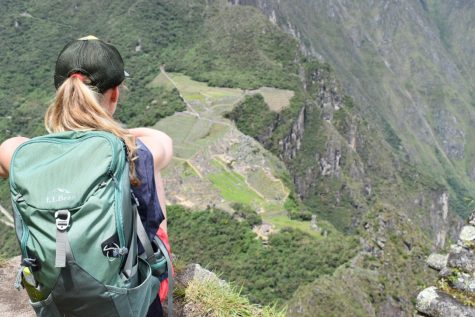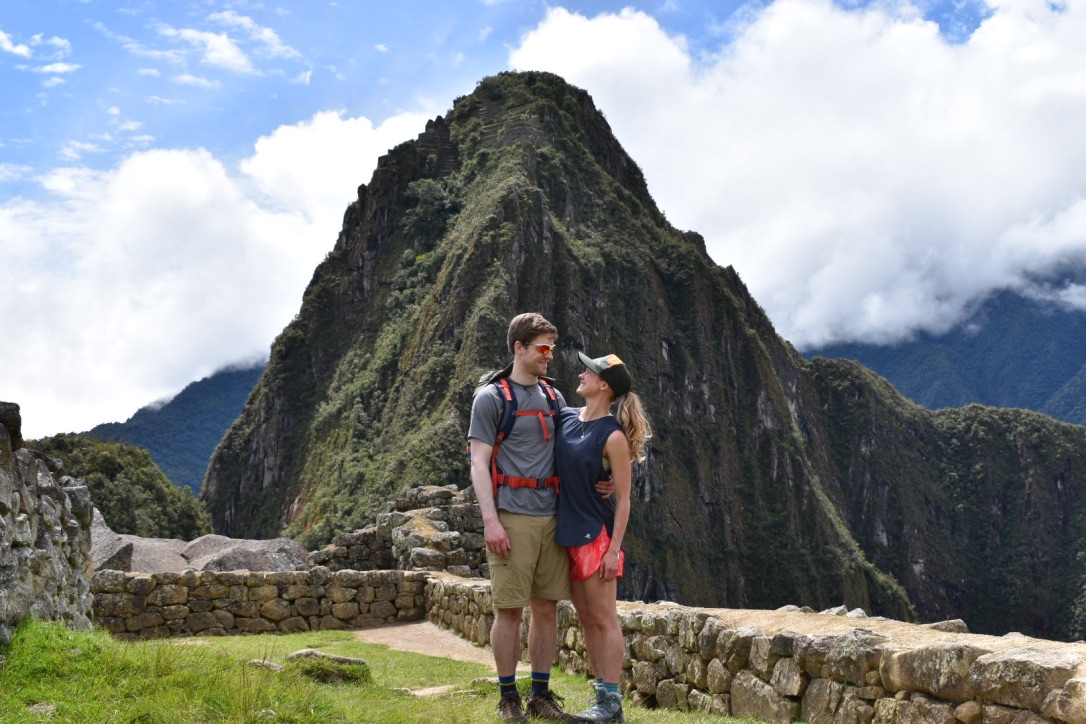I’m back! Ready for part two of the Salkantay trek, and Machu Picchu? Picking up where I left off, we woke up nice and early (thanks to Heihei the slightly confused rooster, whom I still haven’t forgiven), and started our third day with…a van ride!
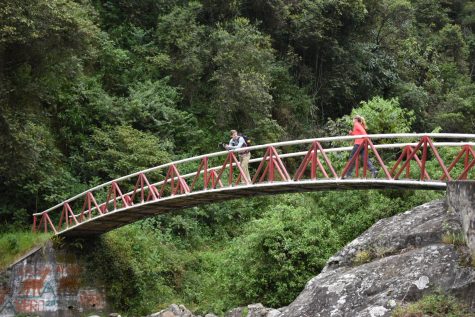
Only in Peru does the graffiti feature…Llamas?!? (photo from Cesar)
Cesar had learned the night before that there had been a huge landslide that took out the hiking path we were supposed to go on a few weeks ago. They had dug out a new path through the slide, but just three days ago it slid once again, and thank goodness for our guide figuring that out ahead of time! We said goodbye to the horses and the porters who had taken care of them, and took a car on the bumpy dirt road across the part of the valley that was most prone to landslides. While Wade and I were stunned by the jaw-dropping cliffs that our left wheels were only inches away from, neither Cesar nor our driver were the least bit fazed. “Slides are very frequent around here!” the driver told us, in a gross understatement. We lost track of how many slides we saw, and how many times we drove through a slide that had been bulldozed to clear a narrow path for cars. This. Was. Epic! Again, like I said…they just make them tougher in the Andes.
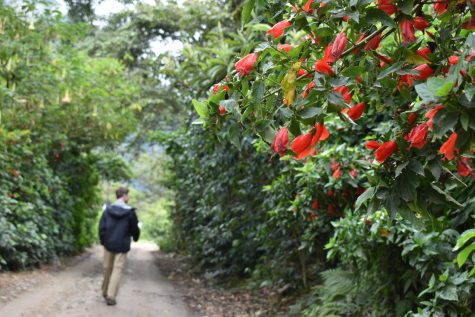
I don’t have photos from our car ride, but the road we walked after was gorgeous and full of flowers!
After almost an hour’s drive, we got out of the car and walked the rest of the way to the small village of Lucmabamba, or, as Wade would pronounce it…”luuuk-at-mah-bumba”. We loved this place.
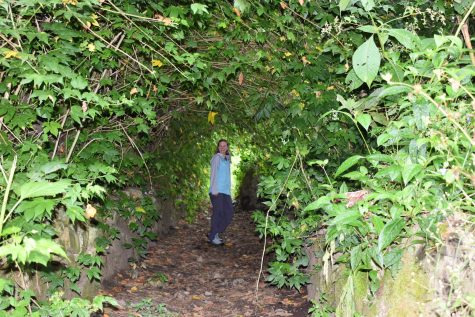
Layers on layers of green!
Little campsites were offered along the single dirt road that was the main road, and most campsites were also small plantations that grew anything from coffee to bananas, passionfruit, guavas, avocados, yucca, corn, plantains and potatoes.
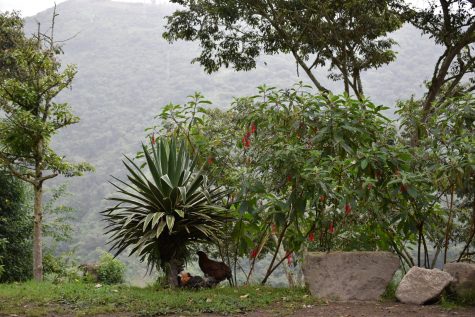
Much smarter chickens lived at our campsite with us this time around.

Our campsite for night 3 of the trek!
If you have the chance, I highly recommend the place we camped at, Flor de Cafe. The adorable couple there grow and make their own coffee (some of which we brought back with us! Don’t tell US Customs!) but the best part was that the owner gave us an awesome tour of his farm, explaining how he cares for and grows each plant and letting us pick and then eat a variety of things!
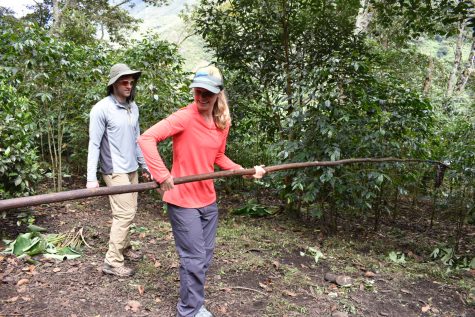
Picking avocados with a long pole attached to a basket.
I had tasted passionfruit juice before, but never peeled and eaten one fresh, and it became my favorite snack. After breaking the harder shell and peeling away the soft white almost fuzzy stuff around the fruit, you get this wobbly, clear jello-like mass of seeds, each surrounded by juicy little blobs of fruit. It was as if a pomegranite, a jelly fish and chia pudding decided to join forces inside this bright yellow shell. “Like a monkey brain!” Cesar told us, “just suck it out, break the fruit in your mouth but don’t crunch the seeds and swallow it!”’ That was one delicious monkey brain.
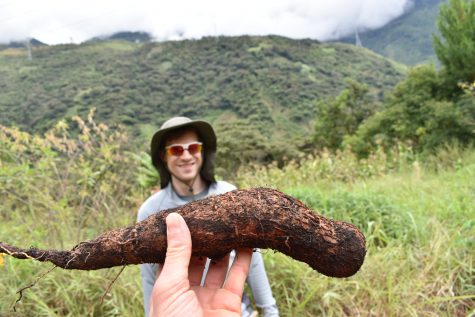
Yucca root!
But first, coffee.
We picked a number of coffee fruits from one of the many Arabica trees on his farm, then brought them over to the cement bins where the farmer would hand crank the wheel of the machine that separated the red skin of the fruit from the beans within, the skin falling to the back and the beans dropping to the floor of the container. I had no idea how exactly coffee was made before this (I gathered the roasting the green beans and grinding part, but the steps before that were a mystery to me) and it was surprising to me to learn that when I put a fresh green bean in my mouth it was covered by a sweet sort of sap, a film covering the bean.
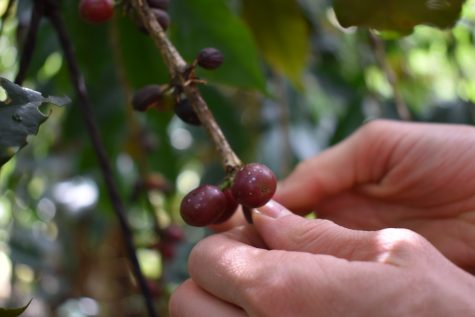
Ripe coffee fruit is red, and the beans inside it are green.
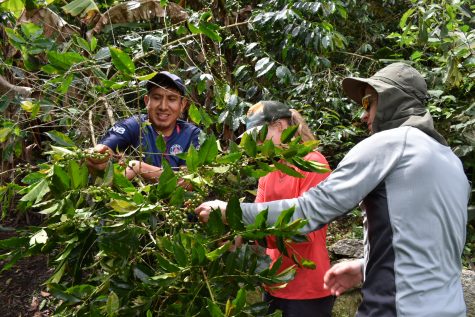
Our new farmer friend holding the Arabica coffee tree as we picked the ripe fruits.
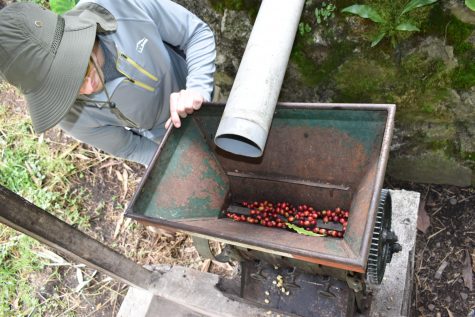
Wade operating the machine that separated the shell from the beans.
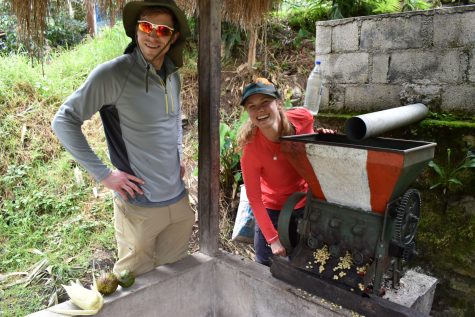
Honestly, we were having way too much fun with this!
Then came the part we cheated because we didn’t actually have three days; the farmer explained that he would fill the basin with water and the beans that floated to the top were bad, and were scooped out. The rest would be thoroughly washed, then dried out for three days before the light shell covering the bean was taken off.
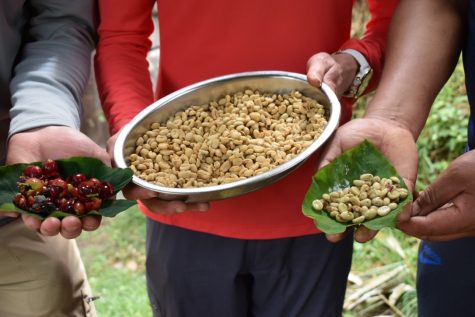
The red shell, the slimy green beans, and in the pan the beans that had been washed then dried out.
When you were left with just the dried green beans, this is the stage where many coffee companies purchase the beans from this area of the world and roast them themselves. This is when we took a bunch of the beans over to a corner of the farmer’s covered stone patio, where a small pot was placed over a fire that we took turns stoking by blowing air through a rod into the flames. The beans were roasted in the pot with one of us constantly stirring them around, and near the end some sugar was added to give them extra flavor.
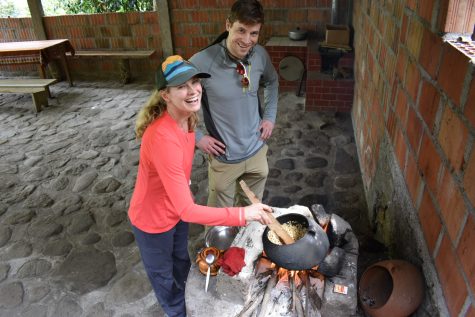
Roasting our own batch of coffee!
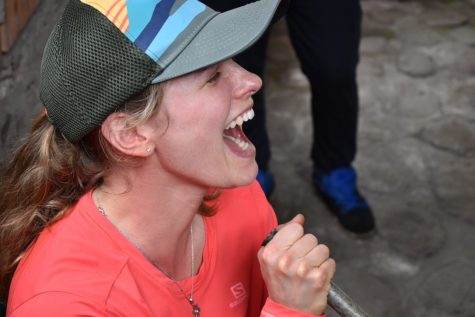
My face when Wade said that between the two of us, he’s the chef 🙂
When the beans were nice and black and the air smelled ridiculously good, the beans were poured into a basket where we stirred them around as they cooled down.

Cooling off the freshly roasted beans.
Then we ground the beans, in a hand-cranked grinder the farmer told us was relatively new – his parents had ground the coffee by pounding the beans with a large rock that was in the corner. The smell of the freshly ground coffee was straight up ridiculous.
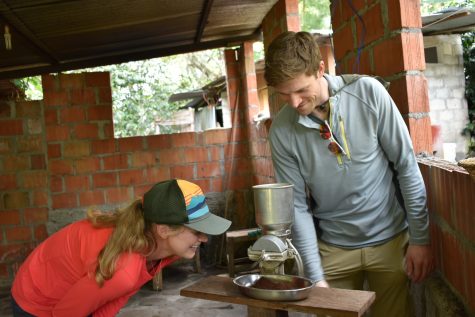
This smelled amazing.
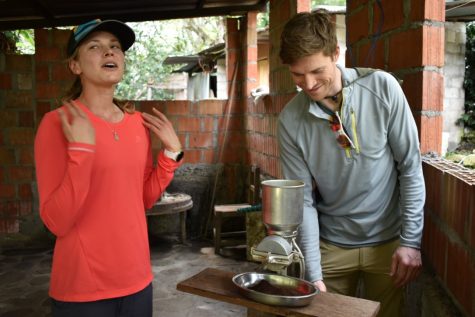
Just trying to get all the coffee smells.
We enjoyed a few cups while simultaneously enjoying the view of all the farms dotting the valley of the cloud forest. What a peaceful way to spend the afternoon!
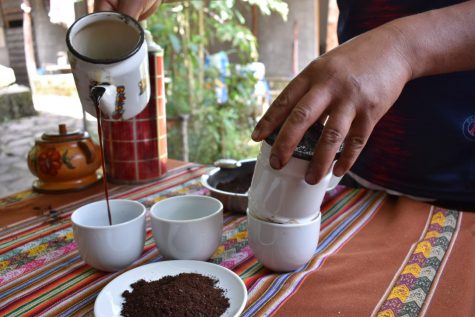
Pouring the coffee!
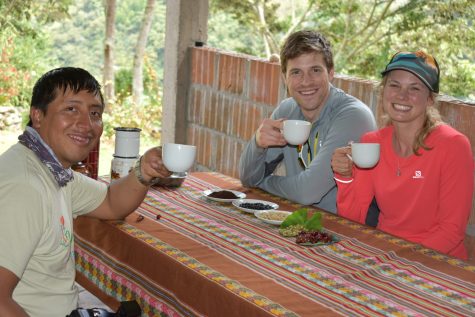
Cesar, Wade and I enjoying the coffee we’d just made.
But wait…it gets better. In what can only be described as a view taken straight out of Jurassic Park (the first movie, obviously!) were the hot springs of Santa Teresa. These weren’t hot springs that smelled like old eggs or had murky water, either – the pools spaced along the edge of the cliff had hot spring water and cold mountain water constantly circling through and out of them, with a small waterfall of freezing cold water where you could cool off. If you want your trip to be romantic, you should definitely go here. Just saying. You’re welcome.
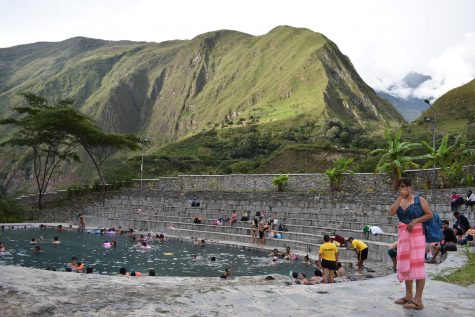
The hot springs.
The next morning started bright and early at 5am, with our last delicious breakfast from our chef before climbing up for a few hours.

So much green! So many ferns! Bamboo! Vines! Wow!
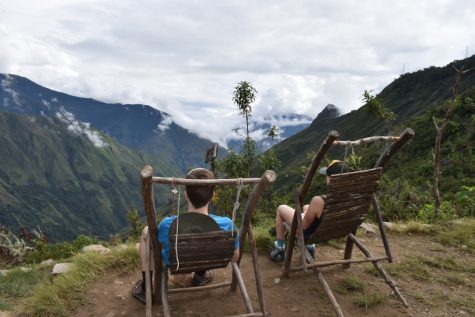
Taking a chill break nearing the top of the mountain
At the top of the mountain, we had our first view through clearing clouds of Machu Picchu, across the valley and Urubamba river far below us! It was so incredible to see these ruins from far away…we marveled at how long it took for them to be discovered after the last Incas fell to the Spanish around 500 years ago. It’s absolutely amazing that they were discovered at all, however, because of how overgrown they were at the time, how high up and protected the city was, and how the ever-changing cloud forest often completely obscured any view of the lost city.
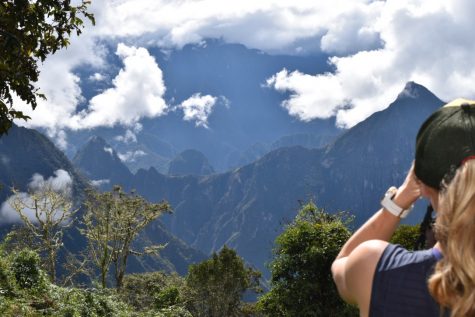
Machu Picchu is tucked into the tiny “flat” section near the left of the mountains you see in the photo.
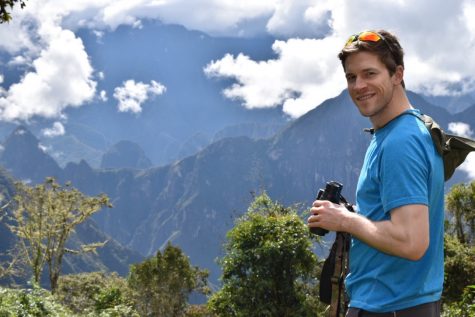
Just another absolutely awesome model shot of Wade.
We learned that although Hiram Bingham was given a lot of credit for “discovering” Machu Picchu, he wasn’t actually the first to find it. Farmers in the area knew it was there, and another explorer from Cusco had found it as well. However, Hiram was the one who brought in the archeological team and made it famous to the world (and stole artifacts, some of which were only recently returned, by the way. Seems like a great guy!) so he gets much of the credit. Either way, I’m just grateful the Spanish didn’t know about it’s existence when they took over Cusco, because they destroyed (or converted to Catholic churches) most of the Quechua culture, while Machu Picchu, thankfully, remained intact.
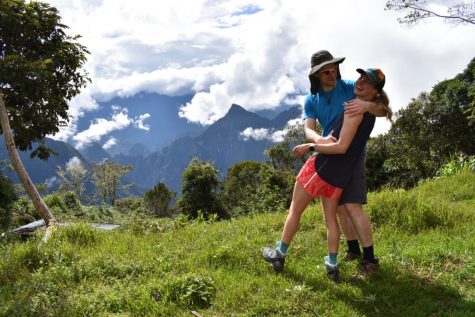
Happy dance now that we’d seen how close we were to Machu Picchu!
We started to climb down and on our way saw the incredible Inca ruins of Llactapata, a site thought to have been used for ceremonies along the Inca trail we were hiking. It was interesting to see that a lot of these stones were placed using mortar, in opposition to the perfectly aligned stones of Sacsayhuaman. As the Incas became more advanced over time, they figured out how to make these virtually seamless walls, so any earlier work (or less important work, such as houses where the less important people lived at the time) were not as perfect looking and used mortar. It was so cool to see what was important to the Incas (usually, religious sites) by the quality of their buildings!
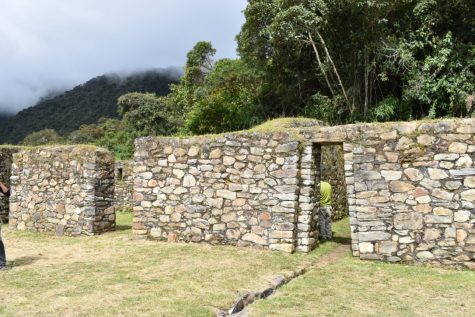
Llactapata ruins, the uncovered part.
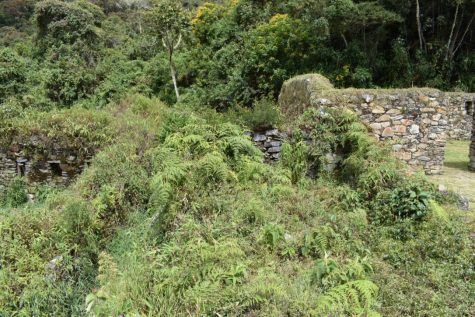
Part of Llactapata, still overgrown and covered by nature!

The view of the mountains with Llactapata at our back. Basically, views on views this entire trek.
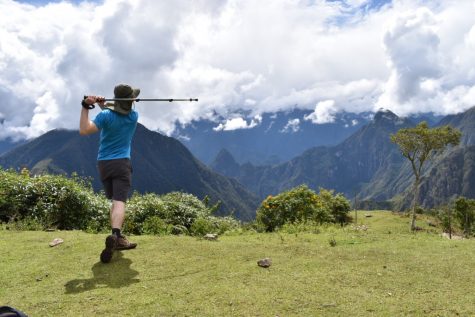
Wade, “golfing” his way over to Machu Picchu.
By the time we made it down the other side of the mountain and along the river to the hydroelectric plant we had the choice. We’d either walk for 1.5-2 hours along the railway or catch a train to the town of Aguas Calientes, or as it’s recently been renamed, Machu Picchu Pueblo. Either name still works – everyone will know what you’re talking about. It was astounding, the difference between this town and the ones we’d passed through on our hike…tourism to this area had made Aguas Calientes a bustling town filled with restaurants and hotels. The bumpy dirt road gave way to beautiful walking paths and paved streets. In a very happy twist of events, our original hotel had overbooked and offered us a free upgrade to the Inkaterra Pueblo hotel, the nicest hotel in town, and that was more than ok by us! After walking 7.5 hours that day a hot shower, incredible food and tea while strolling through their orchid gardens was a perfect end to the day. Needless to say, we felt pretty spoiled, but enjoyed every second of it!

I can’t even tell you how awesome a hot shower and getting off my feet felt! Wow!
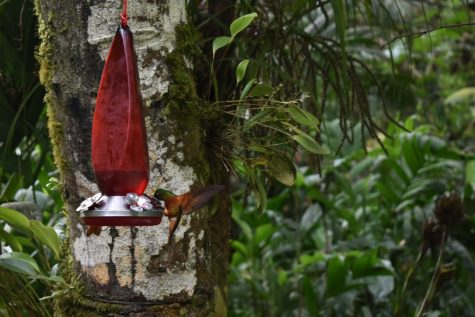
There were hummingbirds everywhere in the hotel gardens. I loved watching them!
So here’s the part that’s new about visiting Machu Picchu – due to the number of people from all around the world who want to visit, you have to get your permit ahead of time (especially if you want to hike Huayna Picchu, the steep mountain overlooking the city) and now the permits come with an entry time. Once you enter, you’re supposed to leave after 3 hours, so that it’s not overcrowded for any group of people. Although to be honest, around 4 in the afternoon it was much less busy, so if you want the clear photo…do the afternoon!
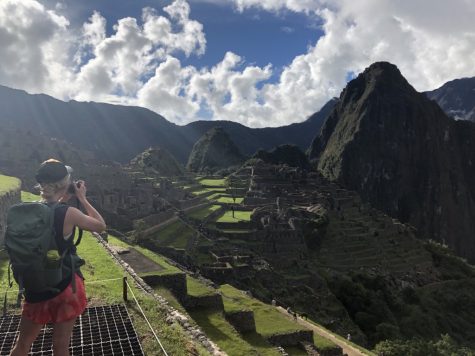
Me, “getting the shot”, without a whole lot of other people at 4pm.
The entry time system was awesome because instead of a crazy bus line starting at 5am, we were able to enjoy a nice breakfast and then get in line behind the 8am entry sign, avoiding a lot of waiting and stress to get up there in time. When we arrived the city was socked in by fog and clouds, and it was easy to see how Machu Picchu had evaded attention for so many years…you just couldn’t see the dang thing!
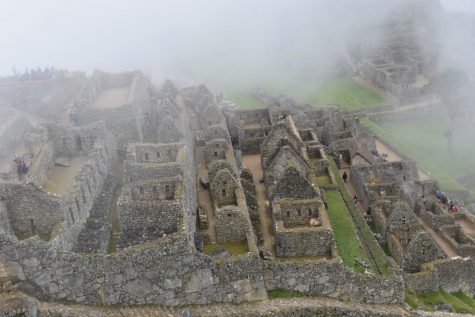
A slightly spooky ghost village! This is the part where the normal people lived.
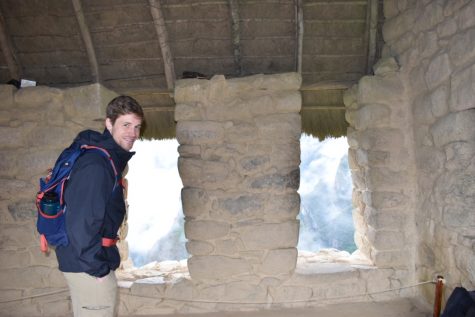
Wade, looking out the windows from the Guard Hut.
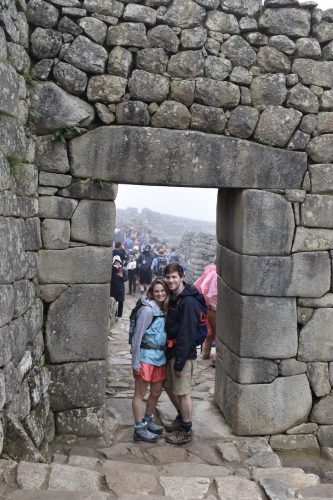
Wade and I, without any other tourists in the background. Haha, just kidding! Just accept early on that you will have tourists in your photos and you will enjoy your visit a whole lot more!
Honestly, the fog swirling around made it feel pretty mystical and slightly creepy, which I loved. It was really cool to see more and more of the ruins uncovered as the sun burned through the fog, and by 11am it was fully sunny out!
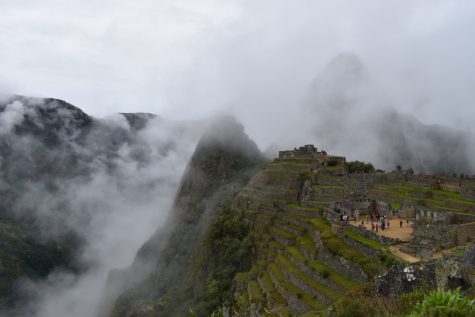
A side view to show just how many levels of terraces there were, supporting Machu Picchu and preventing slides!
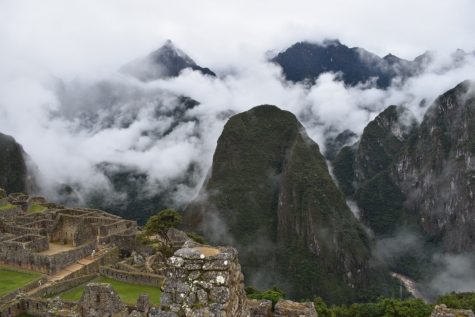
Loving the fog in the mountains.
Cesar showed us around the ruins, and it was so cool to see the different parts of the city and how it functioned. One of the coolest things were the water channels built into the mountain to move natural spring water at exactly the right grade in order to provide a constant flow of water to the city year round. It’s so impressive how smart the Incas were and how they worked with nature, not against it!
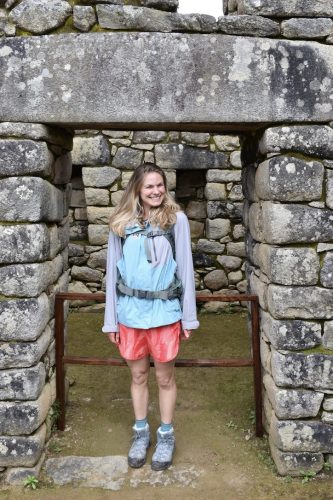
I’m 5’4”, so myself and all the other Hobbits fit right into the building plans! Where the normal citizens lived, the doorways were not that tall!
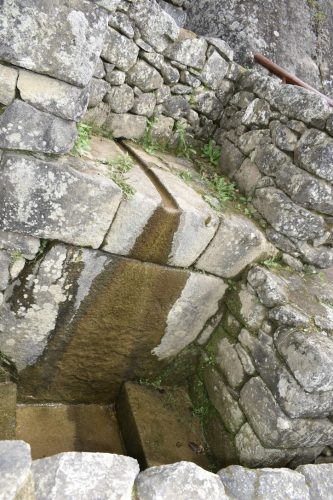
One of the many water channels flowing through the city.
We hiked Huayna Picchu (pronounced “why-nah pee-choo”), and it was relatively short compared to what we’d been walking every day, but fun in how steep and exposed it was. The view looking down on Machu Picchu was very cool, and even better after we’d learned more about it so we could see how the city planning worked from above!
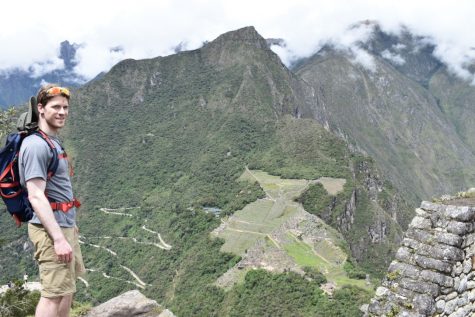
A bird’s eye view of Machu Picchu.

Hiram Bingham, or maybe that’s Wade.

On the tippy top of Huayna Picchu!
On your way back down from Huayna Picchu, you will need to crawl through a small cave. I thought this might be pertinent to mention because clearly, some folks behind us were unaware of the cave part, and “I don’t like this I don’t like this I DON’T LIKE THIS” echoed behind us for a little while as they scooted their way through.
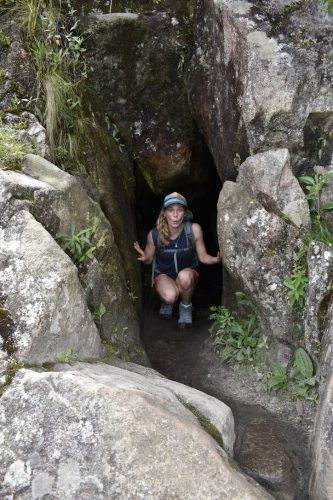
I, however, DID like the cave!
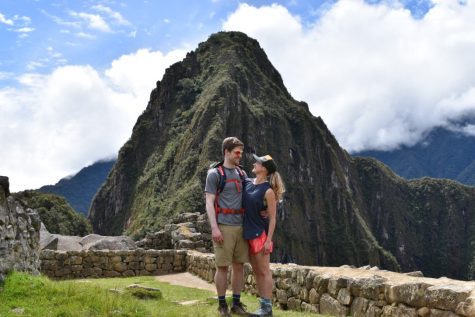
Happy and hungry hikers (with Huayna Picchu behind us)
After our hike we ate a pretty incredible meal at the Sanctuary Lodge (the only place up on the mountain, right outside the entrance gate) before heading back in for the afternoon. It started to rain, which felt awesome and cooled us off as we hiked up to the sun gate, which was opposite Huayna Picchu. This was where the Incas, after hiking from Cusco via the famous Inca trail, would have had their first glimpse of Machu Picchu.
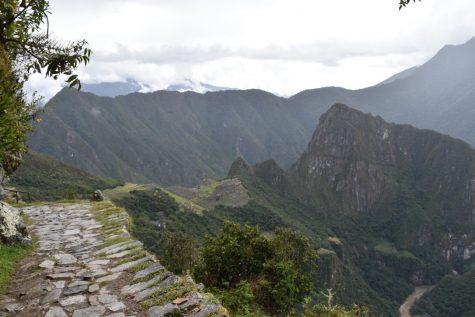
The Inca trail and a view from the opposite side of Machu Picchu.
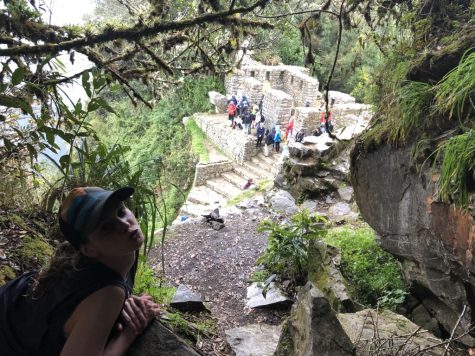
Hiding from the rain, with the Sun Gate in the background.
Because this is the cloud forest, after all, the rain and clouds cleared within the hour and we were treated to a breathtaking golden hour (and a half…it was a long golden hour) as the sun started to lower.
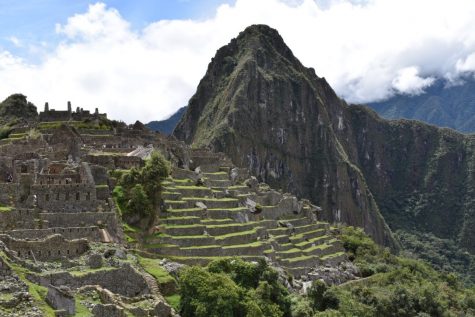
Gorgeous.
We had a train back to Cusco that evening, so we had planned to take a bus down to Aguas Calientes. But as Cesar had warned us, the lines for the buses on the way down aren’t regulated by an entry time, so it can be a little crazy. We were nervous about making it back in time, so we hiked back down (ahhh! MORE stairs!) and had time to get an ice cream (ok, so the stairs were worth it after all) before boarding the train back and flying back home the following day.
My recommendation, if it works for your travel plans? Stay in Aguas Calientes another night. Go up with a guided tour of Machu Picchu in the morning to learn all about the city, and even if there’s clouds or fog in the morning, don’t worry – it will clear up. Hike Huayna Picchu for sure, then have lunch at the Machu Picchu Sanctuary Lodge or pack your own picnic. Then have an afternoon permit so that you can do another entrance with any extra hikes you want to do – the Sun Gate was particularly cool, and doesn’t require a permit! That way you can enjoy and explore without feeling rushed, and if you get skunked on the weather for one entrance time, you have another. Stay for the sunset (around 5pm), and hopefully the bus line will be less crazy than it was for us. If not, it’s only an hour walk down to town and you won’t be worried about catching a train because you have another night to enjoy before your travel back to Cusco and home!
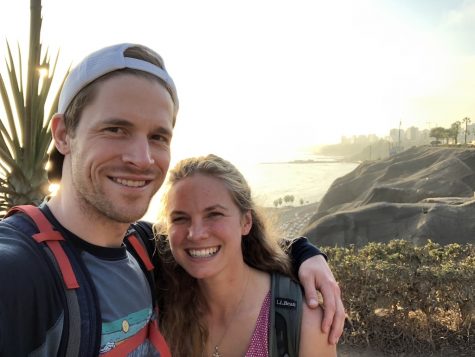
Wade and I walking along the coast in Lima on our travel day home.
On our travel home, we had a 14 hour layover in Lima, and here’s what I’d definitely recommend if you also have a long layover! Check your bags in “stored luggage”, the blue wall at the far end of baggage claim. It’s only $13 to store a bag for the day and it’s worth it to not haul it around the city! Then catch the Airport Express bus to the Miraflores district. The bus is safe and cheap, and they have a guide on the bus who will tell you when it’s your stop based on what hotel (or restaurant) you want to get off at. Definitely, definitely, absolutely, FOR SURE get yourself a reservation and eat at Amáz, a restaurant that pulls fresh food from the rainforest and surrounding area into their meals and serves a creative take on dessert that I would recommend to anyone who enjoys good things in life. Then walk along the edge of the bluffs overlooking the ocean, watch the surfers below or just wander around looking at the unique houses!
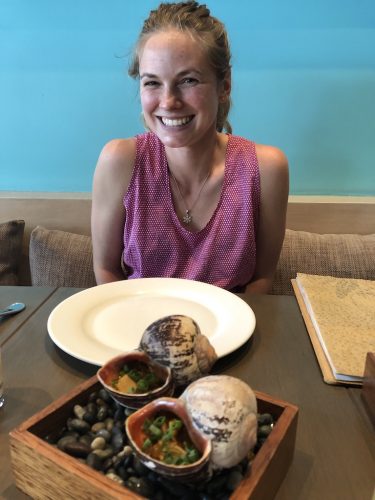
River snails for appetizers at Amaz…these were tasty little buggers!
Overall, this was such an incredible experience for Wade and I. I loved getting to see a totally new part of the world, someplace where ski racing will never take me. I was excited to learn more about their culture and history! I felt so at home in the Andes mountains, and the culture I got to experience and the people we met made a lasting impression. If you get the chance to visit someday, enjoy every second of it!
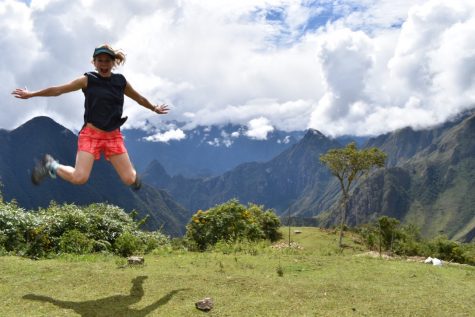
Loving it!
But wait! One more thing. The gear guide, for those of you who might be planning a trip and are looking for recommendations on what to bring. We put a lot of thought into what we were packing as we didn’t check a bag, and here’s the list of what we loved best! I’ve linked to the women’s version of all these, but guys, it should be pretty easy to find yours too.
The day packs: Because sweaty backs are gross (and I should know, I sweat for my job), get yourself a nice pack. These light and small backpacks kept us cool but also held all the essential gear for the day. Women’s Trekker Air Carry Pack by LL Bean
The hiking boots: Wow. I can’t say enough how incredible these were. I have pretty rough feet (flat, bone spurs, weird poky bones, just gross in general) and these got me though full days of hiking with zero issues. Wow, wow, wow. Quest Prime GTX W by Salomon.
The water filter: For those times when you don’t want to trust the water, this was incredibly fast and light to carry. Katadyn BeFree Water Filter from LL Bean
The first aid kit: for peace of mind (also bring anti-diarrhia meds and ibuprofin pills, just in case). Adventure Medial Kit from LL Bean.
The sleeping bag liners: renting sleeping bags is awesome…and so is having your own liner to put in it. Enough said. You’ll need the liner to add warmth when you’re camping up high, and when you’re in the rainforest you may want to sleep in only the liner to stay cool. Sea to Summit Thermalite liner from LL Bean
The portable pillows: in line with the “Gucci camping” experience of having amazing food and horses to carry our equipment…why not actually get a good night’s sleep, as well? We loved these little blow-up pillows. Sea to Summit inflatable pillow from LL Bean
The packable hoodie: We went through a LOT of different climates. We didn’t always need this layer, but when we did, we REALLY did. As a bonus, it was very cute. Primaloft Packaway Hooded Jacket by LL Bean
The light tank top: A mesh back was amazing, especially hiking with a pack on! Light and breathable, and also cute. Thanks, Salomon. Comet Breeze Tank
The hiking shorts: These went up and over mountains, no problem…all while fitting a phone into the side pocket. Agile Short by Salomon.
The zip-off hiking pants: They’re pants. Nope, now they’re shorts. They’re convertible without needing to actually take your pants off. Genius. Vista Zip off pants by LL Bean
The raincoat: Armpit zippers, light and breathable fabric, cute. Need I say more? Nope. Tek O2 Element Jacket by LL Bean
The rain pants: Incredibly light and easy to roll up into the bottom of my day pack, these were awesome for the sudden showers. Lightning Race WP pant by Salomon
The wear-on-the-plane or around the camp pants: So cute. So light. So cozy. Comet Pant by Salomon
The sweater: don’t be silly, buy one with Llamas on it when you get there.
I’ll stop just shy of recommending hiking underpants as well (although, you know…pack a lot, or be prepared to do sink laundry). Happy camping!
